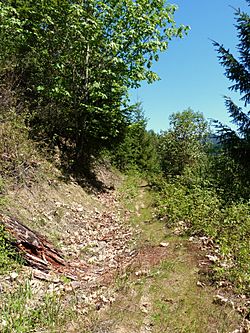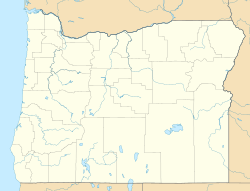China Ditch facts for kids
Quick facts for kids |
|
|
China Ditch
|
|

A section of the China Ditch trail in 2013
|
|
| Nearest city | Myrtle Creek, Oregon |
|---|---|
| Area | 38.1 acres (15.4 ha) |
| Built | 1890–1894 |
| Built by | Myrtle Creek Consolidated Hydraulic Gold Mining and Manufacturing Company |
| NRHP reference No. | 91000616 |
| Added to NRHP | May 22, 1991 |
The China Ditch is a historic canal located in Douglas County, Oregon, in the U.S. state of Oregon. This 30-mile (48 km) long waterway was built to provide water for hydraulic mining, a method of using high-pressure water to find gold.
A big part of the ditch was built by Chinese workers. The company behind it, the Myrtle Creek Consolidated Hydraulic Gold Mining and Manufacturing Company, started buying land for the ditch in 1890. However, the company went out of business by 1894.
Even today, you can still see parts of the ditch. It used to carry water from Little River to North Myrtle Creek. An 11-mile (18 km) section of the China Ditch is now recognized as a special historical site and is listed on the National Register of Historic Places.
The Bureau of Land Management helps people explore the ditch. They maintain a driving route and a hiking trail so visitors can see this important piece of history.
Contents
Discovering Gold in Oregon
Many people who settled in the area first came west during the California Gold Rush. After the rush, some moved north to start farms in Oregon. But when gold was found in Douglas County, Oregon, in the 1860s, many went back to mining.
By 1889, miners planned to find gold in new areas around North Myrtle Creek. They believed the nearby hills had a lot of gold. By 1890, two large hydraulic mining machines, called "giants," were in use. These machines shot powerful jets of water to break apart the ground and find gold. However, they could only work for about three months each winter when there was enough water.
Building the China Ditch
To make the "giants" work longer, the Myrtle Creek Consolidated Hydraulic Gold Mining and Manufacturing Company decided to build a large ditch. This ditch was planned to be 5 feet (1.5 m) deep and 3 feet (0.91 m) wide at the bottom. It would carry water 33 miles (53 km) from the Little River to North Myrtle Creek.
After surveys showed the project was possible, 80 men started building. By early winter, they had finished 7 miles (11 km) of the ditch. The company's president, L. W. Brown, hoped the ditch would also provide water for farms and transport timber.
Chinese Workers Join In
In June 1891, the company hired 100 Chinese workers to continue building the ditch. They helped extend the ditch and connect it to four more creeks. This is how the ditch got its name, "China Ditch."
As part of this work, they built a 400-foot (120 m) tunnel through a mountain. This tunnel connected the new water sources to the existing ditch. Thanks to this extra work, three "giants" could operate all day and night by the end of that year. By the spring of 1892, only 3 miles (5 km) of the ditch were left to build. A fourth "giant" machine started working in April 1893.
The Company's Challenges
On June 1, 1893, the company started facing serious problems. The local court ordered that the company's property be held because of unpaid bills. Over the next few days, other groups also demanded money. The company owed $4,420 in unpaid wages to workers and $6,000 in other debts.
The court stopped the company from selling its property or shares. The county sheriff was told to guard the property until the issues were fixed.
Gold Shortage and Sale
The sheriff decided to clean out the gravel in the sluices (parts of the mining equipment). He found only about 9 ounces (260 g) of gold. This was much less than the 75 ounces (2.1 kg) that was expected. People thought the company might have made it look like there was more gold than there really was. They also thought the company hired too many workers just to seem busy.
On July 4, 1893, the court sided with the miners, and the company had to close down. On October 19, 1894, the company's property, mining claims, and the China Ditch were sold for $7,691.
The China Ditch was officially added to the National Register of Historic Places on May 22, 1991, recognizing its important place in history.



